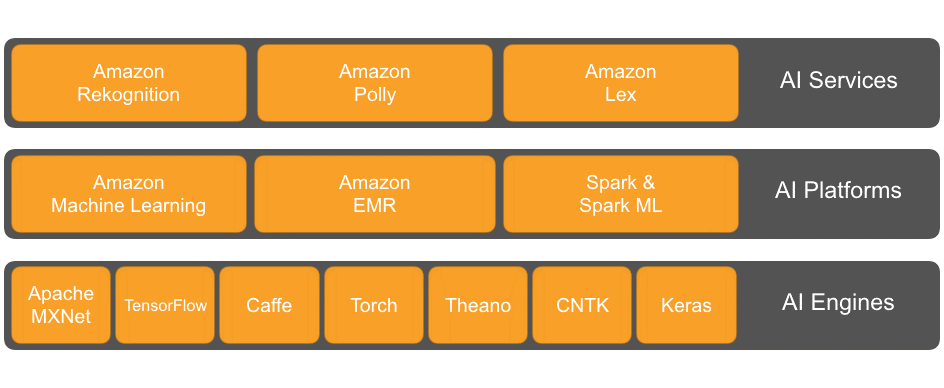AWS Public Sector Blog
All in on AI: Artificial Intelligence in the Public Sector
From computer vision systems for autonomous driving to FDA-approved medical imaging, artificial intelligence (AI) is driving public sector innovation. Governments, defense agencies, and other public sector organizations are adding AI into their platform, solutions, and products to perform tasks that usually require human-level intelligence, such as visual perception, speech recognition, decision making, or translation.
In order to change the way services are delivered to the blind or to inspire the next generation of space explorers, organizations need to overcome hurdles related to the scale of data, scale of compute, and variety of devices and platforms that intelligent systems need to ultimately run on. To be able to realize impactful results, Amazon AI breaks down services into three main layers, which sit on top of the AWS infrastructure and network:
- AI Services: Application developers can easily add built-in intelligence into their solutions using the Amazon AI Services. AI Services are powered by machine learning and deep learning, but provide higher level services to add intelligence into your applications. These AI Services include: Amazon Rekognition for image and facial analysis, Amazon Polly for text-to-speech, and Amazon Lex, an automatic speech recognition and natural language understanding service for building conversational chat bots. Within the public sector, Rekognition is being used to build facial search databases, user verification, sentiment analysis, and image classification and tagging of entities.
- AI Platforms: If you have existing data and want to build custom models, we provide a set of AI platforms which remove the heavy lifting associated with deploying and managing AI training and model hosting: Amazon Machine Learning (with both batch and real-time prediction on custom linear models) and Amazon EMR (with Spark and Spark ML support).
- AI Engines: A collection of open-source, deep learning frameworks for academics and data scientists who want to build cutting edge, sophisticated intelligent systems, pre-installed configured on a convenient machine image. Engines, such as Apache MXNet, TensorFlow, Caffe, Theano, Torch, and CNTK, provide flexible programming models for training custom models at scale. For example, Apache MXNet scales almost linearly across hundreds of GPUs, training efficient models which can be run anywhere from new, custom Intel processors and field-programmable gate arrays (FPGAs) to embedded devices on robots and drones.
AI in the Real World
The below organizations serving the public use some of Amazon AI services:
Nonprofits: The Royal National Institute of Blind People is able to change the way services are being delivered to the blind by using AWS. “We are currently using Amazon’s Speech-to-Text technology to create and distribute accessible information in the form of synthesized audio content for our many B2B and B2C customers, including utility companies, financial institutions, and media companies, as well as other customer-facing material such as magazines and publications. With the announcement of Amazon Polly, we’re excited about the ability to provide an even better experience to these customers by delivering incredibly lifelike voices that will captivate and engage our audience,” said John Worsfold, Solutions Implementation Manager, Royal National Institute of Blind People.
Health: Ohio Health, a nonprofit health organization, is utilizing evolving speech recognition and natural language processing technology to enhance the lives of its customers. “Amazon Lex represents a great opportunity for us to deliver a better experience to our patients. Everything we do at OhioHealth is ultimately about providing the right care to our patients at the right time and in the right place. Amazon Lex’s next generation technology and the innovative applications we are developing using it will help provide an improved customer experience. We are just scratching the surface of what is possible,” said Michael Krouse, Senior Vice President Operational Support and Chief Information Officer, Ohio Health.
Government: Leveraging Lex, the backend that powers Amazon Alexa, NASA, in order to spark innovation, has built a voice activated version of the MARS robot. A star robotic ambassador is “Rov-E,” a close replica of real NASA Mars rovers. NASA staff can easily navigate Rov-E via voice commands. Multi-turn dialog management capability enables Rov-E “to talk,” answering students’ questions about Mars in an engaging way. Integration with AWS services allows Rov-E to connect and scale with various data sources to retrieve NASA’s Mars exploration information.
Financial Services: Using Amazon EMR, FINRA is able to capture, analyze, and store a daily influx of 75 billion records in order to identify fraud and other anonymous activities.
Law Enforcement: Using various models, ShotSpotter delivers real-time gunshot notifications to law enforcement so they can dispatch to the precise location of the gunshot, engage with the community, look for evidence and occasionally help victims and make arrests. Their goal is to help drive down illegal gun use.
Defense Agencies: The defense community is also starting to use machine learning systems to identify advanced persistent threats in their networks. They are using machine learning to provide enhanced endpoint protections and predict the potential threat of certain behaviors by privileged users with system admin roles.
Education: Ivy Tech Community College of Indiana uses machine learning for more than 70% accuracy in predicting students who are struggling, enabling faster intervention.
Learn more about AI at AWS here as well as in Werner Vogels’ keynote from the AWS Public Sector Summit and other AI-related sessions.
